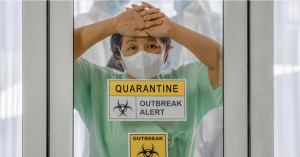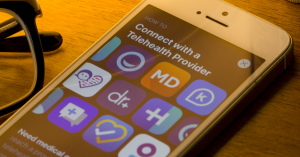Estimated reading time: 5 minutes
It’s no secret that the COVID-19 Virus has accelerated the drive to adopt further ‘futuristic’ technology offerings for nearly every industry.  Taking the cake has to be healthcare industry who was essentially ‘thrown to the wolves’ though means of surviving this deadly pandemic. Hospitals and Primary Care Centers were hardly given any other route of action, when it came to adopting pivotal technology strategies and tools to help adapt their workplace and the opportunity to continue to provide care for those who needed it most during these weird and unpredicted times. 2020 was a big year for the terms “data analytics”, “Telehealth”, “remote patient management” and so many other ground-breaking initiatives, and without their aid, it’s unlikely any healthcare environment would have been able to keep up with the several thousand patients seeking care both in-room and at home. COVID-19 was a kick to many facilities who didn’t have the staff or the efforts to give to the incoming pour of cases, so many were forced to provide care in non-traditional environments, such as hallways, lobbies, and even parking garages. Digital healthcare solutions sought to provide relief where traditional practices weren’t able to, and in return have laid out some essential, foundational groundwork for healthcare to come and how it shall look as months and years go by.
Taking the cake has to be healthcare industry who was essentially ‘thrown to the wolves’ though means of surviving this deadly pandemic. Hospitals and Primary Care Centers were hardly given any other route of action, when it came to adopting pivotal technology strategies and tools to help adapt their workplace and the opportunity to continue to provide care for those who needed it most during these weird and unpredicted times. 2020 was a big year for the terms “data analytics”, “Telehealth”, “remote patient management” and so many other ground-breaking initiatives, and without their aid, it’s unlikely any healthcare environment would have been able to keep up with the several thousand patients seeking care both in-room and at home. COVID-19 was a kick to many facilities who didn’t have the staff or the efforts to give to the incoming pour of cases, so many were forced to provide care in non-traditional environments, such as hallways, lobbies, and even parking garages. Digital healthcare solutions sought to provide relief where traditional practices weren’t able to, and in return have laid out some essential, foundational groundwork for healthcare to come and how it shall look as months and years go by.
Telehealth: Here, There, and Everywhere
Telehealth was known of, before the start of COVID-19, but primarily for those living in rural regions or those recovering from a large surgery procedure and require some follow-up video call sessions, to check the status of symptoms and health stats. Now, it’s probably one of the most commonly utilized resources, to help stop the spread of in-person contact, while also receiving care and/or a referral to take a COVID-19 test, in light of any known symptoms popping up. Healthcare officials sought to rapidly amp up Telehealth efforts in every part of the country, in hopes of training their personnel and patients on how to navigate this new digital landscape effectively. It was predicted that more than 1 billion Telehealth visits would be conducted throughout 2020, and more than 1 million visits were recorded from January to March alone; so many relied and still do rely on this resource.
Read More from VARTECH Nation: Standing Up for In-Home Healthcare
It’s been found that 12% of users accessed Telehealth and Telemedicine resources to benefit that of their mental health needs.  Through the usage of a quality camera, psychiatrists and therapists have been able to view their patients’ living spaces lingering in the background of the Telehealth call, allowing them to evaluate critical aspects such as “How much lighting does this room let in?”, and “Does the Patient have any House-Hold Clutter?”, or even analyzing how their day-to-day well-being seems to be progressing. All of this seemingly basic data can help therapists paint a better diagnosis for their patients when it comes to meeting up for an appointment. The Pandemic hasn’t been easy for most people, and with the constant concern for physical sickness being on the horizon, mental health has been placed at an equal standing as well. Because telemedicine is completed through virtual means, therapists are able to amplify their methods for promoting positive patient engagement through the usage of external wearable devices to track goals, apps & chatbots to circle back on symptoms and thoughts, and several other check-in procedures tailored to each patients’ needs.
Through the usage of a quality camera, psychiatrists and therapists have been able to view their patients’ living spaces lingering in the background of the Telehealth call, allowing them to evaluate critical aspects such as “How much lighting does this room let in?”, and “Does the Patient have any House-Hold Clutter?”, or even analyzing how their day-to-day well-being seems to be progressing. All of this seemingly basic data can help therapists paint a better diagnosis for their patients when it comes to meeting up for an appointment. The Pandemic hasn’t been easy for most people, and with the constant concern for physical sickness being on the horizon, mental health has been placed at an equal standing as well. Because telemedicine is completed through virtual means, therapists are able to amplify their methods for promoting positive patient engagement through the usage of external wearable devices to track goals, apps & chatbots to circle back on symptoms and thoughts, and several other check-in procedures tailored to each patients’ needs.
Vaccination on the Horizon
Globally the vaccine is rolling out much slower than I’m sure we all expected, and with that being said, many are curious as to when it will be their turn to be vaccinated. Thousands of frontline workers, politicians, and elderly at-risk individuals have already received their first dosage of the shot, with the booster following shortly after in a few weeks. This is great progress, but as the months roll on inward, it will be up to the healthcare professionals to maintain a sense of various patient engagement tools to reassure those who are unsure and provide some relief, from a customer service standpoint.
Many facilities’ Electronic Health Records (EHRs) have been preparing themselves to monitor the presence of vaccine records and report them back to the appropriate health department,  so such data can be catalogued necessarily. It’s the goal that EHRs will be correctly communicating with patients through their primary care center’s app/portal/website so they can have access to such regularly updated reports. In order to deploy an effective vaccination strategy, health IT leaders need access to the right data points for who qualifies to receive the vaccine in a specific order. Many states and regions have already figured this out and placed participants into a tiered phase schedule.
so such data can be catalogued necessarily. It’s the goal that EHRs will be correctly communicating with patients through their primary care center’s app/portal/website so they can have access to such regularly updated reports. In order to deploy an effective vaccination strategy, health IT leaders need access to the right data points for who qualifies to receive the vaccine in a specific order. Many states and regions have already figured this out and placed participants into a tiered phase schedule.
The most accurate patient data must be matched to the correct patient, so that they can receive the appropriate dosages of the vaccine. This accomplishment will need to rely on the team efforts of pharmacists, public health officials, providers to ensure that they all have access to the most updated patient data and vaccine records. The VA has launched a specific database to better connect and increase interoperability for veterans, as they enter their phase. VDIF is connected to 130 separate EHR systems that support 172 VA Medical Centers and several thousand outpatient clinics that will work to assist and disperse the vaccine to those VA members who have contracted the virus.
The Healthcare market is now favoring more digital strategies than ever before and we have only the pandemic to thank for that. During the past 8-10 months, we experienced healthcare enterprises increase their focus on enhancing online interactions through digital tools and resources.  From virtual care and beyond, there are so many emerging technologies coming to light in a dark and gloomy situation. If you’re interested in learning more about how these healthcare strategies are impacting everyone within the channel, be sure to head over to our YouTube Channel to watch one of our favorite podcast episodes, where we linked up with our Healthcare Tech Guru, Matt Jordan, who serves as Zebra’s Healthcare BDM. In this episode we dive deeper into the hot trends within the Healthcare field and explore new opportunities for providing care to patients in need. Be sure to subscribe wherever you listen to your podcasts and as the new unravels itself, it’s likely we’ll be unlocking some new healthcare-oriented episodes in the days to come.
From virtual care and beyond, there are so many emerging technologies coming to light in a dark and gloomy situation. If you’re interested in learning more about how these healthcare strategies are impacting everyone within the channel, be sure to head over to our YouTube Channel to watch one of our favorite podcast episodes, where we linked up with our Healthcare Tech Guru, Matt Jordan, who serves as Zebra’s Healthcare BDM. In this episode we dive deeper into the hot trends within the Healthcare field and explore new opportunities for providing care to patients in need. Be sure to subscribe wherever you listen to your podcasts and as the new unravels itself, it’s likely we’ll be unlocking some new healthcare-oriented episodes in the days to come.

